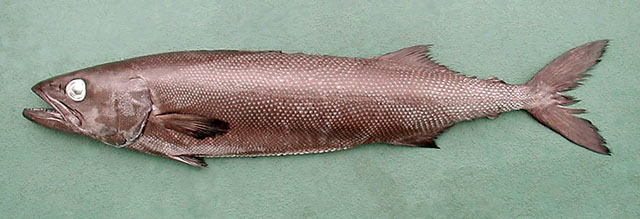| Gempylidae (Snake mackerels) |
| 300 cm TL (male/unsexed); max.weight: 64 kg |
|
benthopelagic; marine; depth range 100 - 975 m, oceanodromous |
| Circumtropical and temperate seas of the world. |
|
Dorsal spines (total): 13-15; Dorsal soft rays (total): 15-18; Anal spines: 0-0; Anal soft rays: 15-18; Vertebrae: 32-32. Skin very rough, scales interspersed with spinous bony tubercles. Mid-ventral (abdominal) keel on the ventral contour. Body is uniformly brown to dark brown, tips of the pectoral and pelvic fins black, margins of the second dorsal and anal fins white in young specimens. |
| Usually over the continental shelf, sometimes in oceanic waters down to 800 m (Ref. 9302). Usually solitary or in pairs near the bottom (Ref. 6181). Migrates far offshore (Ref. 26139). Pelagic (Ref. 5951). Feeds on fish, crustaceans and squid (Ref. 6181). The peculiar wooden 'palu' or Ruvettus hook is used to catch this species in south central Pacific (Ref. 6181). The flesh is very oily, with purgative properties, if eaten much (Ref. 6181). Marketed fresh and as fish cakes in Japan (Ref. 9302); also processed into fishmeal (Ref. 5217). Maximum length reported to reach up to 2 m only (Heemstra, pers. comm. 03/03). |
|
Least Concern (LC); Date assessed: 22 August 2012 Ref. (130435)
|
| poisonous to eat |
|
Source and more info: www.fishbase.org. For personal, classroom, and other internal use only. Not for publication.

